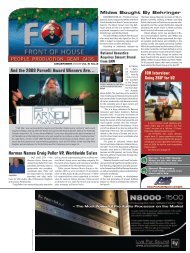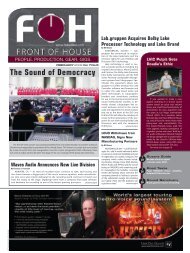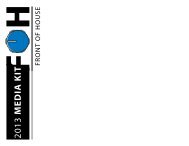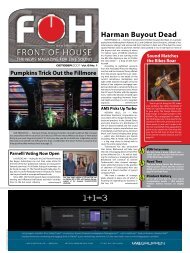Create successful ePaper yourself
Turn your PDF publications into a flip-book with our unique Google optimized e-Paper software.
By DanDaley<br />
Scientific protocol calls for lots of<br />
testing before a product is finally<br />
assembled. However, in the highly<br />
subjective and opinionated realm of<br />
loudspeakers, testing has become not<br />
so much an afterthought as an afterthe-fact<br />
proposition in some instances.<br />
The transducer and cabinet assembly of<br />
each component in a line array are subjected<br />
to plenty of testing as each element<br />
is developed and connected, but<br />
the dynamic and incrementally minute<br />
nature of the line array itself tends to<br />
get its final checks in situ, flying above<br />
the crowd.<br />
Routine Systems Testing BIZ<br />
JBL has historically been a major<br />
proponent of systems testing — during<br />
the development of the VerTec line array<br />
system at the turn-of-the-century<br />
rigs were routinely set up in the parking<br />
lot and on the roof to check ground<br />
planes and other splays, and in one instance,<br />
an entire system was set up in<br />
an airplane hangar at Van Nuys airport<br />
near the Harman Industries’ headquarters.<br />
“This enabled JBL engineers to<br />
validate correlations of predictive software<br />
tools with actual measurements<br />
of large-scale arrays, which is especially<br />
important with line-array type system<br />
formats,” recalls David Scheirman, JBL’s<br />
vice president of tour sound.<br />
“The issue with very large sound<br />
systems is that the bigger they get, the<br />
farther away you have to measure them<br />
from and it can reach the point where it<br />
becomes less and less practical to test<br />
physically,” comments Paul Bauman,<br />
JBL’s director of tour sound engineering.<br />
Tips ‘n’ Tricks<br />
Combating Feedback<br />
Even though monitor placement is<br />
simple, it is very important. Where you<br />
place your monitors can affect the perceived<br />
tone and be an important tool<br />
in combating feedback. If you ask your<br />
worship band players or singer where<br />
they want their monitors placed you<br />
may find that they have some very specific<br />
ideas about placement. I like to<br />
have my wedge set at about 10 o'clock<br />
to my left. I play 12-string acoustic guitar<br />
at my church and if I place the monitor<br />
directly in front of me, there is a<br />
good chance my guitar will feed back.<br />
At 10 o'clock, I can hear the wedge and<br />
I am off axis for resonance-induced<br />
feedback from my guitar.<br />
— Jamie Rio from his “Sound<br />
Sanctuary” column in the October<br />
2008 issue.<br />
It’s a pragmatic and logistical problem,<br />
but one rooted in ideology as much as<br />
science. “Back in the early days of EASE<br />
there was a debate over angular resolution,”<br />
says Bauman. “The analogy to that<br />
today is whether you can accurately extrapolate<br />
far-field data from near field<br />
measurements.”<br />
A Small and Interesting Niche BIZ<br />
This situation, along with the proliferation<br />
of line arrays being used in applications<br />
ranging from massive arenas<br />
to small clubs, has created a small and interesting<br />
niche, one that more and more<br />
systems designers and component manufacturers<br />
are coming to rely on. In the<br />
1960s and ‘70s, Ron Sauro used to work at<br />
NASA, measuring trajectories that would<br />
help put Voyager, Pioneer and Apollo<br />
spacecraft into space. One of the human<br />
manifestations of the peace dividend,<br />
Sauro now parses data about speakers in<br />
his lab in Santa Clarita, Calif., where his<br />
company NWAA Labs tries to bring some<br />
order to a combination of tricky measurements<br />
and marketing-speak. “It used to<br />
be that you could measure key aspects,<br />
like magnitude and phase, of a speaker in<br />
a system fairly easily when most AP systems<br />
took the form of clusters,” he says.<br />
“Once the line array became popular, it<br />
was slowly realized that it couldn’t be<br />
measured accurately the same way. With<br />
a cluster, you could take all of the far-field<br />
information and trace it back to a single<br />
point in space. But with line arrays, where<br />
the point sources are multiple and highly<br />
variable, you have to measure more and<br />
from farther away to create a meaningful<br />
set of data.”<br />
www.fohonline.com<br />
NWAA accomplishes this with its<br />
MACH (Multi-Angle Computerized High-<br />
Speed) testing system, which uses a proprietary<br />
array comprised of 19 matched<br />
Earthworks M-30 microphones and a<br />
Linear X precision turntable capable of<br />
0.1-degree accuracy. It simultaneously<br />
samples impulse responses within an<br />
anechoic chamber and uses these to<br />
create loudspeaker radiation “balloons”<br />
(a graph of a sound radiation pattern)<br />
in a fraction of the time used by other<br />
testing methods. This data is gathered<br />
by a multi-channel version of EASERA<br />
and is then converted to EASE V4, EASE<br />
V3, CLF 1 and 2 formats for transmission<br />
to the client or user. If you were to apply<br />
the older methodology of taking 2,500<br />
[impulse response] measurements to a<br />
line array, it would take you a week,” he<br />
says. Using MACH, he says they can do it<br />
in less than an hour, yet still measuring<br />
for every possible configuration of LF,<br />
MF and HF boxes at any and all possible<br />
angles, by rotating the box around the<br />
axis of the driver.<br />
Cutting Through the Clutter BIZ<br />
While some of his clients are systems<br />
designers seeking to cut through the<br />
clutter of marketing materials masquerading<br />
as spec sheets, the majority are<br />
actually the speaker makers themselves,<br />
including JBL, Meyer and EAW, seeking<br />
to provide their customers a more valid<br />
way to compare performance characteristics<br />
before a system is hung. What<br />
becomes an enormous amount of measurement<br />
data is codified into a program<br />
called Generic Listening Library<br />
(GLL), that seeks to document and ar-<br />
The Biz<br />
Testing, Testing…<br />
chive performance records of all types<br />
of speakers.<br />
The message, though, should be less<br />
about the data than how it is used, says<br />
Pat Brown, president of Synergetic Audio<br />
Concepts (Syn-Aud-Con) in Greenville,<br />
Ind., and its testing division, Electro-<br />
Acoustic Testing Co., one of a handful<br />
of independent testing facilities in the<br />
sector. “There is good agreement on the<br />
required data set for simple loudspeakers<br />
with modeling as the stated objective,<br />
[but]… it is more important that<br />
the data be appropriate for the device<br />
being tested,” Brown cautions. “Understanding<br />
loudspeaker data is not trivial,<br />
and comparing different loudspeakers<br />
with a few ‘one number’ metrics such<br />
as sensitivity or power handling can be<br />
completely meaningless. Unfortunately,<br />
this is often how the buying decision is<br />
made, and this fact can affect how loudspeaker<br />
specifications are determined<br />
and published. Collecting the data is a<br />
much easier task than conveying to the<br />
end user what it means and how to use<br />
it in a meaningful way.”<br />
Testing at this level is likely to remain<br />
a niche, albeit an intense one.<br />
“There’s something to be said for having<br />
an independent, impartial laboratory<br />
do these kinds of measurements,”<br />
says Bauman. “It’s reassuring to clients<br />
like sound designers who deal with issues<br />
like allocating the resources and<br />
time needed to do it right, which is often<br />
not practical even for large manufacturers<br />
anymore.”<br />
Dan Daley can be reached at ddaley@<br />
fohonline.com<br />
2008 NOVEMBER<br />
47<br />
Ad info:http:// foh.hotims.com
















